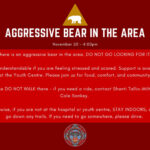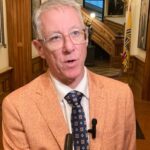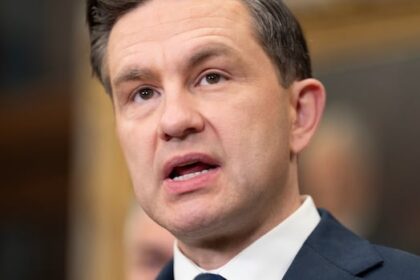IndigenousKen Burns’s new documentary series on the American Revolution includes history often left out of textbooks: the economic and diplomatic roles sovereign Indigenous nations had in the creation of the United States.‘It’s just required,’ says filmmaker on including Native American storiesCandace Maracle · CBC News · Posted: Nov 21, 2025 4:48 PM EST | Last Updated: 35 minutes agoListen to this articleEstimated 4 minutesThe audio version of this article is generated by text-to-speech, a technology based on artificial intelligence.A crew shoots footage for The American Revolution at Ganondagan State Historic Site, a recreated 17th century Seneca town in present-day Victor, N.Y. (PBS)Ken Burns’s new documentary series includes history often left out of textbooks: the economic and diplomatic roles sovereign Indigenous nations had in the American Revolution.The American Revolution, airing this week on PBS, highlights the Haudenosaunee Confederacy in Episode 1 as Benjamin Franklin’s inspiration for union among 13 British colonies in North America, 20 years before the revolution. “They wouldn’t do it. They didn’t want to give up any autonomy, and so they lost the lesson of the Seneca, Cayuga, Onondaga, Tuscarora, Oneida and Mohawk people who had figured this out centuries ago,” Ken Burns told CBC Indigenous. The 12-hour series depicting the bloody clash for Indigenous land involving more than two dozen nations, European as well as Native American, was almost a decade in the making. Indigenous consultants worked on the project. Tuscarora historian Rick Hill said he’s hesitant to watch “because I’m tired of being disappointed by these multimillion dollar productions.”But Burns urges people to watch the entire series before judging it.Ken Burns (standing) with The American Revolution co-directors David P. Schmidt and Sarah Botstein. Burns says his documentaries have a 50:1 shooting ratio (50 minutes of footage per one minute of finished film) so a good deal of footage is left out from the final version. (Joe DePlasco)The prolific documentarian known for series like The Civil War, The Vietnam War and The National Parks: America’s Best Idea, said his desire to tell stories with the accuracy they deserve is in his DNA. Burns said his grandparents found Native American arrowheads, flints and other tools on their honeymoon rather than the intended Civil War artifacts they were looking for.He said growing up, he had a map of the U.S. above his bed with the territories of 300 Indigenous nations, the original inhabitants of the land, at the forefront.“George Washington uses that term ‘empire’ almost all the time,” Burns said, a presumption that ignores the sovereignty of peoples already living there.Behind the scenes of filming reenactments for The American Revolution at Washington Crossing. The series was filmed at over 150 locations. (Jonah Velasco)Burns said it’s interesting this history isn’t taught in schools. “I don’t think engaging the Native American stories is complicated, it’s just required,” he said. “You can’t understand this story without telling the stories of Native people.”The many portraits of Kanien’kehá:ka leader Joseph Brant (Thayendanegea) featured in the documentary are indicative of Brant’s historical stature and command, Burns said, belying the term ‘savage’ Thomas Jefferson used in the Declaration of Independence. “[Jefferson] says ‘merciless Indian savages.’ There’s a lot of work that has to be done in order to live out an earlier sentence of his that all men are created equal,” he said.Divided loyaltiesRick Hill said he didn’t learn anything about Indigenous history until he went to university in the 1970s. There, he met other Indigenous scholars and began talking to the ‘old people’ from his community about the real history of the Haudenosaunee. Hill said at first the lack of Indigenous representation in historical accounts made him angry but spurred him to teach about the history of the Haudenosaunee Confederacy, which is still functioning today.Rick Hill is a Tuscarora historian who does regular workshops on decolonization. (Submitted by Rick Hill)“When it comes to the American Revolution, the Haudenosaunee story is the critical part of the whole thing,” Hill said.Hill said the series is coming out at a critical time, as there are attempts to once again “whitewash history.” The Revolutionary War tore the Haudenosaunee Confederacy apart, Hill said, “to the one point where we’re spilling each other’s blood, despite what the Peacemaker said. We overcame that.“This is the story of betrayal, of divided loyalties but how our culture and our law in the end helped us survive all of that, because we’re still here today,” he said.Cherokee consultants Jen Loren, senior director of Cherokee Film from the Cherokee Nation in Tulsa, Okla., was a consultant on the documentary. The Cherokee Nation was displaced from their homelands in the southeastern United States, the Carolinas and Georgia in the 1700s by the Indian Removal Act. It is the largest tribe in the United States with 460,000 plus citizens.Jen Loren is a Cherokee documentary filmmaker. She said she was ‘humbled’ to work with Ken Burns and his team on The American Revolution. (Submitted by Jen Loren)Loren said Indigenous advisors were brought in early and Burns’s production didn’t simply lump all Native Americans together. She said The American Revolution depicts Indigenous leaders and diplomats from sovereign Native nations, just like the French, British and Americans. She said she hopes people take note of Burns’s approach in his storytelling.“I feel like it’s great to be included but as far as my perspective as inclusion as Native Americans in film and media in general, we have a long ways to go,” Loren said.ABOUT THE AUTHORCandace Maracle is Kanien’kehá:ka, Wolf Clan from Tyendinaga Mohawk Territory. She has a master’s degree in journalism from Toronto Metropolitan University. Her latest short film, “Tsi ní:yoht yonkwayentá:’on ne óhses” (How We Got Maple Syrup) is completely in the Kanien’kéha language.
Friday, 21 Nov 2025
Canada – The Illusion
Search
Have an existing account?
Sign In
© 2022 Foxiz News Network. Ruby Design Company. All Rights Reserved.
You May also Like
- More News:
- history
- Standing Bear Network
- John Gonzalez
- ᐊᔭᐦᑊ ayahp — It happened
- Creation
- Beneath the Water
- Olympic gold medal
- Jim Thorpe
- type O blood
- the bringer of life
- Raven
- Wás’agi
- NoiseCat
- 'Sugarcane'
- The rivers still sing
- ᑲᓂᐸᐏᐟ ᒪᐢᑿ
- ᐅᑳᐤ okâw — We remember
- ᐊᓂᓈᐯᐃᐧᐣ aninâpêwin — Truth
- This is what it means to be human.
- Nokoma











